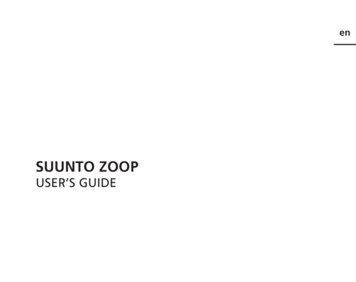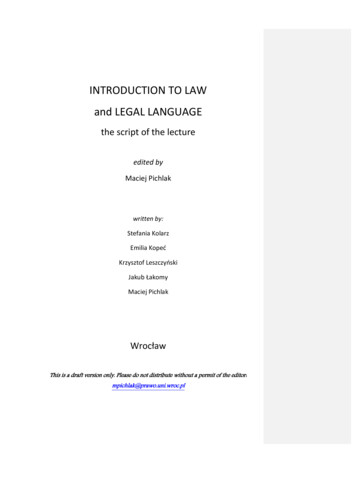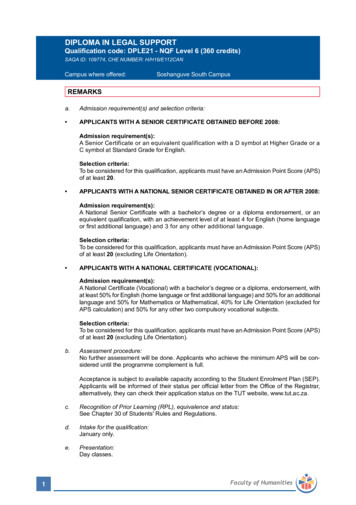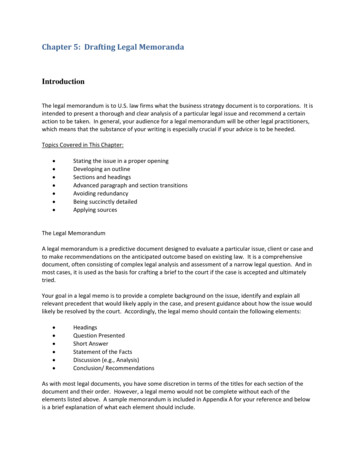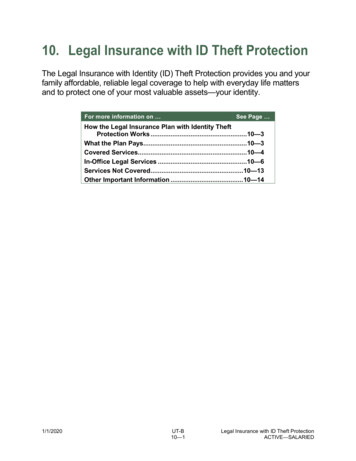
Transcription
Legal Loansharking:A Dive into the Merchant Cash Advance IndustrybyNoah BrittonAn honors thesis submitted in partial fulfillmentof the requirements for the degree ofBachelor of ScienceUndergraduate CollegeLeonard N. Stern School of BusinessNew York UniversityMay 2021Professor Mary BillingsProfessor Marti G. SubrahmanyamProfessor Simone LenzuFaculty AdviserThesis Advisor
AcknowledgementsFirst, I would like to thank Professor Simone Lenzu, my advisor, for encouraging me to writethis thesis and for helping me every step along the way. I originally did not plan to join thehonors program, but he convinced me that I would enjoy academic research and even helped meget into the program after the application deadline. He also introduced me to the topic of thisthesis, which I probably would have never heard about otherwise. Thank you also to ProfessorsMarti Subrahmanyam and Mary Billings for organizing this program that allows students tospend a year researching an interesting topic. Thank you to my family for giving meopportunities like this and for supporting me along the way. Finally, thank you to my friends forencouraging me to work on my thesis and for distracting me from doing so.
I. IntroductionThis paper focuses on the merchant cash advance industry, which utilizes technology tofill a gap in the financing market caused by financial regulations. The merchant cash advance is aform of financing for small businesses that usually have no other means to borrow money. Thisis an under-the-radar industry, largely overlooked by academia, media, and government and as aresult has virtually no regulation. As you will read in this paper, this has led to shady practices,fraudsters making millions, and the bankruptcies of thousands of small business across theUnited States. Most lenders in this industry are privately-owned and take great measures to keeptheir information a secret – there is little public data on this industry. In this paper I detail theorigins of the merchant cash advance, demonstrate how and why this industry is exempt fromregulation, explain the math behind it, discuss if the industry is beneficial or harmful to theborrower and overall market, and explore how regulation can and should impact the industry.II. Payday Loans: The PredecessorA payday loan is a loan made to an individual in need of quick cash. It is usually shortterm, with repayment typically within a couple of weeks from origination. These loans areunsecured and usually given to subprime borrowers who may have low or no credit score andwould likely be denied a loan from a traditional bank. They carry high interest rates called “fees”that range from 10- 30 for every 100 borrowed. For example, if a person borrows 100 with a 15 fee and pays it back in two weeks, this is the equivalent of 400% annual percentage rate(APR). To put this into perspective, the average 30-year fixed-rate mortgage for a house is under3% APR 1 and the 10-year US Treasury rate is approximately 1.6%. 2 In its heyday, payday12“Current Mortgage Rates: Compare Today’s Rates NerdWallet.”“TMUBMUSD10Y U.S. 10 Year Treasury Note Price & News - WSJ.”
lenders would use illicit and misleading tactics to convince borrowers who could not afford torepay their debt to borrow a new sum of money as part of a “refinancing”. It is common for thelenders to pressure the borrowers into taking new loans, each incurring additional fees.Combined, these two effects create a debt spiral that can trap consumers and make it difficult toever pay off the loan entirely. In 2011, the Dodd–Frank Wall Street Reform and ConsumerProtection Act authorized the creation of Consumer Financial Protection Bureau (CFPB) whichbegan to regulate payday lenders. The Bureau ensures that payday lenders cannot mislead,harass, or pressure consumers into taking additional loans. In addition, 28 states have passedlaws that either cap the maximum interest rate a lender may charge (called a usury law) orbanned payday lending outright. 3 Overall, the payday loan industry is an 11 billion market inthe United States in 2021 4 and is largely subject to regulations at the state level and hasconsumer protections from the CFPB.III. Merchant Cash Advance: ExplainedThe merchant cash advance (MCA) is essentially a payday loan for a business. Abusiness will receive a lump sum of capital and will pay back a multiple of that amount withautomatic daily deductions until it is paid off. These loans are typically collateralized byaccounts receivable. These loans are generally short-term, with little paperwork involved, andthe money is received in as fast as 24 hours. The typical firm taking an MCA is a small-tomedium sized business that is a subprime borrower, typically paying a much higher interest ratethan a typical business loan. It is estimated that in 2016 MCA borrowing summed to around 10billion, with a default rate up to 600% higher than loans from the U.S. Small Business34“Legal Status of Payday Loans by State.”“IBISWorld - Industry Market Research, Reports, and Statistics.”
Administration. 5 Many borrowers find the MCA to be a last resort option, if they are unable toget a loan from a bank and because “cheaper loans backed by the Small Business Administrationare tough to get and can take months to close.” 6In order to quantitatively demonstrate how the math behind an MCA works, thefollowing is a table that breaks down a hypothetical MCA. As shown, the borrower will receive alump sum of 10,000. The borrower will owe an amount larger than the amount received. Thisfigure will be equal to the advance amount times the buy rate, also known as the factor rate. Inthis example, the borrower will repay 13,500 because the buy rate is 1.35x on 10,000.The terms of the MCA specify how the advance will be repaid. Unlike a traditional loan,the borrower does not pay the lender in fixed amounts. Instead, the borrower repays the MCAwith automatic electronic payments. More specifically, a designated percentage of daily, weekly,or monthly credit card sales will be directly sent to the MCA provider until the borrower pays theentire payback amount. Notice how words like “interest rate,” “debt,” or “loan” are not used todescribe an MCA. This is because an MCA is classified as an “advance” rather than a “loan.”Even though a loan and an MCA both involve receiving a sum of money that must be paid off,regulators do not consider an MCA a loan. MCA insiders argue “they aren’t actually charginginterest—they’re buying the money businesses will make in the future, at a discount.” ��OnDeck IPO: Shady Brokers Add Risk in High-Interest Loans - Bloomberg.”7“How Two Guys Lost God and Found 40 Million - Bloomberg.”56
Although it seems like a pedantic distinction, by not being classified as a loan MCAs areavoid the laws and regulations that are associated with lending. For example, banks that lend aresubject to Dodd-Frank and Basel III, whereas MCAs are able to skirt these regulations, whichinclude capital and disclosure requirements. 8 In addition, MCA providers are not subject to usurylaws, which act the limit the maximum percentage of interest that can legally be charged.Remember that payday loans (to individuals) were deemed predatory, and as a result becamesubject to stricter financial regulation. This has not happened for the MCA industry, despitebeing a larger industry in terms of dollars. In sum, MCAs are not considered loans, so they arenot subject to those regulations; usury laws do not apply to MCAs and there are virtually noregulations on MCAs. Therefore, MCA providers can legally charge whatever APR equivalentthey desire without disclosing it to the borrower. This has been proven in court as recently as2018. Champion Auto Sales, LLC et al. v Pearl Beta Funding, LLC in the state of New Yorkfound (in a unanimous decision) that MCA lending in excess of the usurious limit is permitted. 9The following graph shows the size and fast growth of the MCA industry. The MCAindustry is a small percentage of the overall lending in the United States and the world. However,the outcomes of these loans have real effects on real small businesses and real people. It isestimated that payday lending (which can be thought of as MCAs for individuals instead of smallbusinesses) is an 11 billion industry. That industry is subject to usury laws, and its borrowersare protected by the Consumer Financial Protection Bureau. This is an example of an industry89“Paskelian and Bell - THE TALE OF TWO REGULATIONS — DODD-FRANK ACT AND B.Pdf.”“It’s Settled, Merchant Cash Advance Not Usurious DeBanked.”
that became regulated because it was deemed predatory. In contrast, the MCA industry is aneven larger industry, at 15.3 billion in 2017, and is almost entirely an unregulated industry.20Estimated Annual Dollars (billions)Funded in MCA Industry15Industry Size (in10billions of dollars)8.612.810.715.3502014201520162017YearIV. The History of the Merchant Cash AdvanceThe merchant cash advance industry is relatively new. MCAs are only possible with theadvent of digital payments. Credit cards became widespread in the 1990s, and the MCA industryclosely followed. It is believed that AdvanceMe in Georgia became the first MCA provider in1998. These MCAs required a personal guarantee. In other words, if the business was unable torepay the advance, the individual would be responsible. It is uncommon for the modern-dayMCA to involve a personal guarantee.Originally, AdvanceMe had a patent on MCA technology, which meant it was the onlyprovider at that time. In 2007, a Texas judge invalidated AdvanceMe’s patent on cash advancesagainst future credit card transactions, allowing new MCA firms to compete. Within the nextyear, the 2008 crisis and following recession greatly changed the financial system. Firstly, banksas a whole became more reluctant to underwrite loans. Loans were risky, and after the housingand financial system collapse, banks were risk averse. Secondly, the banking system sawconsolidation. Large banks absorbed many smaller regional ones. Between 1998 and 2015, the
number of large banks increased by 32% and the number of small banks decreased by 38%.Small regional banks have traditionally been, and still are, more willing to lend to small andmedium sized businesses, as compared to large, multinational banks. Historically, big banksapprove roughly 22% of small business loans, compared to small banks approving 49%. Theeffect was twofold: banks reduced lending to small businesses overall due to uncertainty in theeconomy, and small banks which are more likely to lend to small businesses were replaced withlarge banks. Experts believe that regulations and compliance costs disincentivize big banks fromlending to small businesses because the regulatory costs are not worth the small dollar amountloans. For a small bank, the dollar amount of a small business loan is more meaningful to thebottom line of the firm. 10 The aftermath of the financial crisis led to more regulations,exacerbating this issue. Legislation like Basel III and Dodd-Frank made the financial industrymore cumbersome, which to some extent reduced small business lending. Overall, small businesslending (which is defined as business loan less than 1 million) has declined throughout theUnited States over the past decade. This represents more than a 12% decrease in small businesslending from 2007 to 2015. As a result of these changes, many small businesses were unable toobtain a traditional loan from a bank. The need for financing still existed, so small businesseswere forced to look for alternative ways to borrow money. This led to the merchant cash advancebecoming more .Pdf.”
Small Business Lending in the United States ( 1m, exlcudingreal estate, in 01220132014201550040030020010002007200820092010V. OriginationMerchant cash advance providers source their clients in one of two ways, each making uparound half of the advances in the industry. The first is directly, meaning their internal marketingteam will find merchants in need of an advance. The second is through an Independent SalesOrganization (ISO). Both methods involve cold calling and sending spam faxes to smallbusinesses.The ISOs will charge the MCA provider a one-time commission, usually around 5-10%of the advance amount. In order to cultivate relationships with the ISOs and increase the numberof leads they receive from them, MCA providers sometimes allow ISOs to invest in a portion ofa merchant cash advance that they source. This means that the ISO will contribute capital(usually a maximum of 50% of the advance amount) and become an investor in the deal. TheMCA provider will service and collect the advance and pay the ISO its share. However, becauseof this passivity and relying on the MCA lender to realize a return, some legal scholars believethat this aspect of MCA may fall under the jurisdiction of federal securities laws. Law firm
Troutman Pepper opines that “In SEC v. WJ Howey Co.,2 the U.S. Supreme Court establishedthe following four-factor test for identifying the existence of a security: (1) an investment, (2) ina common enterprise, (3) with a reasonable expectation of profits, (4) to be derived from theentrepreneurial or managerial efforts of others.” 11 The bottom line is that this is not settled law.The merchant cash advance industry is young, and the intricacies of the legal aspect have notbeen decided. There exists a chance that as the industry is around for more time, regulators willexamine it more closely, and more regulation will be added. Merchant cash advance providersrely on third-party financing in order to originate advances and conduct operations. It is possiblethat the way many of these firms obtain financing will be deemed illegal under federal securitiesregulations for violating the Howey test.As part of the underwriting process, MCA providers conduct a due diligence. This mayinvolve analyzing bank statements, monthly credit card sales volume, the age of the company,and the rent-to-sales ratio. It is not uncommon for an MCA provider to mandate the business usea particular point of sale (POS) terminal that will account for and automatically remit thepayments to the MCA on a daily, weekly, or monthly basis. Merchant cash advances do notheavily rely on FICO credit scores or the credit of the merchant. In fact, many small businessowners decide to take out an MCA only when every other type of lender has denied their request.VI. Debt or Equity?In traditional corporate finance, a firm can decide between debt and equity for theirfinancing needs. However, MCAs are distinct from both. In one sense, the company borrowscapital, and must repay with interest, similar to debt. However, MCAs resemble equity in the11Dabertin 1 and Nowak, “Merchant Cash Advance Participations and the Federal Securities Laws Lexology.”
sense that repayment is tied to future firm performance, almost like a dividend –the capital isrepaid on future revenues, and if the firm defaults, the MCA lenders do not get repaid,resembling an equity investment.MCA firms are not technically classified as lenders according to the law. Instead, theyargue they are buying the rights to the future receivables of the firm. As a result, if the firm findsthat it cannot pay back the loan or that the repayment on each transaction becomes too high, it isoften more desirable to cease operations so that there are no more future receivables. And since itis not debt, the “lender” has no claims to the assets during bankruptcy or liquidation. One of thebiggest advantages of traditional debt is that debtholders are the first to be paid back duringliquidation or bankruptcy, which is not the case for MCAs. Therefore, MCAs are riskier thandebt, which means lenders need to be compensated accordingly.Ownership InterestInterest PaymentsRight to influenceborrower?Claim on assets inbankruptcy?Secured on assets?Fixed term length?1212DebtNoFixed or floating,usually notcontingent onborrower’s financialstateOnly in defaultEquityYesDividends, usuallycontingent onborrower’s financialstateMCANoAutomatic paymentsas a percentage ofdaily/weekly/monthlycredit card salesVoting rightsUsually noSenior claimUsually noSometimesLast, after allcreditors paidNoUsuallyN/ASecured on accountsreceivableNoTable adapted from “Classifying Funds: The Type of Contract – Is It Equity or Debt? Simon Taylor’s Blog.”
VII. The Debt SpiralIt is commonplace in the industry to take out additional MCAs on top of an initialadvance. This is known as “stacking.” Similar to the payday loan industry, it is common toborrow additional money if the borrower is unable to pay the initial debt. Both the payday loanand MCA industry have been known to use deceptive practices to convince borrowers to take outadditional sums of money. It is a controversial practice among MCA providers. MCA providersmay approve a small business to take an advance of a certain amount, which is often more thanthe business can afford to pay back. Since they cannot afford to pay it back with their ownincome, they persuaded by the MCA provider to borrow more money to “refinance”. This createsthe debt spiral where the debt becomes insurmountable. For example, if a small business takesout three MCAs each with taking 10% of their credit card revenue, and the business’s marginsare only 20%, the business will lose money on every sale. The following table shows ahypothetical business that has constant monthly revenues of 20,000 that takes an MCA inmonths 1, 4, and 7, each with repayment of 10% of revenue. In the first three months with justone MCA, the business remains profitable. In the middle three months with two MCAs, thebusiness is breakeven. In the final three months, now with three MCAs, the firm has negativeprofits. This is because it pays 30% of its monthly revenues (10% for each of its three MCAs),and has net margins before repayment of only 20%
OneMCAMonth1RevenueTwoMCAs2345ThreeMCAs678920000 20000 20000 20000 20000 20000 20000 20000 20000Net Profit(before MCA)400040004000400040004000400040004000MCA 00Profit200020002000000-2000-2000-2000One MCA provider, Elevate Funding, has a strict no-stacking policy. This firms reasonsthat stacking puts a “strain on your cash flow and available daily balances” and that it creates a“slippery slope” for small business owners to take out more and more money that they cannotafford to pay back. 13 However, this is far from the unanimous opinion of all MCA providers. Thefollowing graph shows the favorability of stacking of CEOs of MCA providers. As shown, only31% of MCA providers are “totally unsupportive” of stacking, meaning 69% support stacking toat least some extent.Favorability of Stacking (0 totally unsupportive, 5 highly supportive)410%54%031%317%217%121%0131“What Is MCA ‘Stacking’ and Why We Discourage It?”2
Some MCA providers encourage stacking because they are able to collect fees on eachadvance. This creates a moral hazard, where the salespeople originating MCAs collect their fees,regardless if the borrower is able to pay back the advance or financially survive. This allows theoriginators to encourage riskier borrowing, since they face no consequences if the borrower goesbankrupt as a result of the MCAs. There is no required license, training, ethics guidelines, orregulation associated with becoming an MCA broker. In fact, the only training for newly hiredbrokers one MCA provider World Business Lenders provides is from sales veteran BryanHerman. Herman was charged with fraud in 1998 after starting his career at Jordan Belfort’sStratton Oakmont, which was depicted in Martin Scorsese’s 2013 film The Wolf of Wall Street. 14Although deceptive practices are common in selling MCAs, many brokers all well-intentionedbut are nevertheless misinformed about the product they are selling, and as a result, pass thatincorrect knowledge onto the borrowers.VIII. Illustrative Merchant Cash Advance NarrativeThe following example is hypothetical but is similar to many true stories of a smallbusiness taking a merchant cash advance.Bill owns a hardware store at the center of his mid-sized town in New York state. Thisstore has been his family’s only source of income for three generations. Although the businesshad been in decline for the past few years, Bill had always found a way to make ends meet andnever borrowed money from a bank. However, the store’s financial condition worsened as aresult of the COVID-19 pandemic. Despite taking a Paycheck Protection Plan (PPP) loan, the14“Wall Street Finds New Subprime With 125% Business Loans - Bloomberg.”
store could not cover its operating expenses. Faced with the decision to either borrow money orclose shop, Bill decided the former was a better option.Bill’s local bank chain had been replaced with a Chase bank several years prior. Billapplied for a loan for his small business. A few days later, his loan application was rejected,largely because he had no credit history. Bill thought there was no way for him to borrow themoney he needs to save his business and had given up hope. Bill saw an opportunity in abillboard ad that claimed to lend small businesses money, even with no credit history.Bill called the number on the advertisement, and the man on the phone told him that hisfirm does not offer a loan, but rather an advance. More specifically, a merchant cash advance.This would give Bill’s hardware store 50,000 to survive the economic downturn. Rather thanpaying the loan back with equal payments over a predetermined time period with a set APR, theMCA terms specify a buy rate. The man told Bill that his buy rate would be 1.3 and thatpayments would be made automatically as automated clearing house (ACH) payments daily as aflat 10% of his credit card sales each day. The man told him he would get the money into hisbusiness account in just 24 hours. Bill did not understand the fine print of the deal nor what a buyrate is, but he saw it as the only way to save his business, so he happily agreed to the deal.The next day, the money was deposited into Bill’s account. At first, Bill was happy withhis MCA. However, each month his expenses remained higher than his revenues, which werenow 10% lower because of the MCA repayment. Bill’s landlord refused to lower his rent, andBill could not reduce his workforce any more than he already had. Each month, Bill used someof his advance to cover his excess expenses. After three months, the 50,000 was gone. At thispoint, his expenses still exceeded his income. However, Bill was worse off than he was before,because in addition to this problem persisting, he now was still paying 10% of his daily revenue
as repayment. Bill returned to Chase bank to apply for a small business loan but was rejectedonce again. Having nowhere else to turn, Bill went to a different MCA firm and took anotheradvance. This time, Bill took out another 50,000 advance to cover his operating expenses forthe next few months. He figured he would borrow again to help his business survive until he wasprofitable, which he thought would be soon.He was offered the same factor rate of 1.3, this time with 20% daily payments. Bill stilldid not understand what these terms meant, but he did know that he needed to borrow moremoney or else his hardware store would go out of business, like so many others in his town. Asdiscussed, this is known as stacking MCAs.Now, Bill is losing 10% of his revenue to repay the first MCA, and 20% to repay thesecond. He cannot even repay his first MCA with the second, because Bill found out that a 1.3factor rate on 50,000 means he owes 65,000 on the original, and the same amount for thesecond MCA. Bill owed a total of 130,000 in exchange for receiving 100,000. Furthermore,Bill must pay 30% of his daily revenues to remain in good standing with his MCAs. However,Bill’s profit margins are well under 30%, so he actually loses money on every sale at the storehis grandfather founded. He explained his case to the bank, which once again rejected his loan.Even though Bill had made every payment on time for his MCAs, it did not have an effect on hiscredit score.Bill had entered a debt spiral – the only way to pay off his debts are to take out new debt,which is unsustainable and would only put him in more debt. He realized that he would never beable to repay the debts and he could not afford to lose money on every sale. After sixty years inbusiness, the hardware store shut its doors.
Now imagine that Bill’s first MCA provided him enough working capital to survive. Hepaid his employees, bought more inventory, and paid his rent. However, at the end of the month,Bill realized that his store had lost money. As agreed, the firm that had given him his MCA hadtaken 10% of his revenue every day that month. Bill’s profit margin was narrow before hisMCA, so losing ten cents on every dollar sold seriously reduced his bottom line. Nevertheless,the MCA allowed Bill to weather his financial hardship, and after around three months, the firmstopped taking their 10% -- he had fully paid off his MCA. Bill was happy. Yes, those monthshad been difficult because of the reduced profits from paying back the advance. However, it wasa small price to pay compared to going out of business.In this example, Bill’s buy rate of 1.3 means that he pays back 1.3 times what heborrowed (or 30% on top of the principal). This means that Bill owed 65,000 on his 50,000advance. Bill paid this off in around three months, which gives an equivalent rate of 0.6% perday, or an astounding 220% annually. In the State of New York, the maximum legal interest rateis 25% per year. However, the MCA provider was able to legally charge more than eight timesthe legal limit because the New York does not recognize an MCA as a loan.IX. The Math Behind the MCAAs discussed, MCA borrowers are typically subprime (risky) small businesses with littlecredit history. In addition, the MCA is not collateralized by any physical asset. As such, MCAproviders are able to charge exorbitantly high interest rate equivalents. Analogous to aprepayment penalty in corporate debt, the sooner the MCA is repaid, the higher the interest rateequivalent. In addition, the input variable to change the number of days to fully repay theadvance is the percentage of revenue remitted to the MCA. Holding all else equal, there is a
direct inverse relationship between the percentage of revenue remitted and the number of days ittakes to repay. Assuming a constant total sum to repay, the percentage of revenue remitted is theonly figure that will determine the number of days to repay the advance. In the example withBill’s hardware store, he paid off his first MCA in three months, which gave him an APRequivalent of 220%. If Bill had paid his loan in six months instead of three, the APR equivalentwould have been half, just 110%. There is an inverse relationship between the time to repay theMCA and the APR equivalent: if the borrower remits a smaller percentage of his revenues, hewill pay the same total sum (borrowed amount times the buy rate), just spread over a longerperiod of time, thus decreasing APR. In order for Bill to have an APR equivalent of his state’slegal maximum of 25%, he would have to spread his payments over more than two years. Thefollowing graph shows how differing number of days to fully repay the MCA affect theequivalent APR that Bill pays.The Effect of Term Length on APR Equivalent700.00%651%600.00%500.00%APR 0.00%306090120133% er of Days
Another major input to determine the APR equivalent is the buy rate. As discussed, thebuy rate determines the total amount of money the borrower will pay to the MCA provider.Therefore, the higher the buy rate the higher the APR, all else equal. The following uses thenumbers from the hypothetical Bill example, changing only the buy rate. As shown, the buy ratecan greatly impact the APR.The Effect of Buy Rate on APR, all else equal350.00%304%300.00%266%250.00%Effective x1.1x1.2x1.3x1.4x1.5xBuy RateBelow is a sensitivity analysis for Bill’s MCA. It shows his APR equivalent for differentcombinations of buy rate and the number of days it takes him to fully repay the advance.Intuitively, the higher the buy rate means the higher the APR equivalent, all else equal. Lessintuitively, the APR equivalent decreases as the time to fully repay the advance increases. Interms of APR, an MCA borrower is essentially penalized for repaying the advance sooner. In asense, the borrower is disincentivized to repay the advance in a timely manner, because to do someans to pay a higher interest rate.
Numberof Days %The following shows a sensitivity analysis of the APR equivalent for differentcombinations of the percentage of sales remitted for the MCA and the buy rate. Like the lasttable, this shows that the higher the buy rate the higher the APR, all else equal. This table alsoshows that the higher the percentage of revenues remitted for the MCA, the higher the APR. Thisshould make sense because holding revenue constant, the higher the percentage of revenueallocated to repaying the
III. Merchant Cash Advance: Explained. The merchant cash advance (MCA) is essentially a payday loan for a business. A business will receive a lump sum of capital and will pay back a multiple of that amount with automatic daily deductions until it is paid off. These loans are typically collateralized by accounts receivable.

